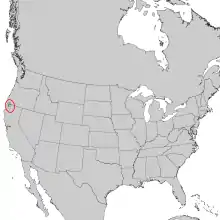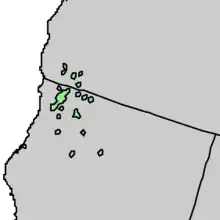Picea breweriana
Picea breweriana, known as Brewer spruce,[2][3] Brewer's weeping spruce, or weeping spruce, is a species of spruce native to western North America, where it is one of the rarest on the continent. The specific epithet breweriana is in honor of the American botanist William Henry Brewer.[4][5]
| Picea breweriana | |
|---|---|
 | |
| Brewer spruce, Ridge above Bear Lake, Siskiyou Mountains, Ca. | |
| Scientific classification | |
| Kingdom: | Plantae |
| Clade: | Tracheophytes |
| Clade: | Gymnosperms |
| Division: | Pinophyta |
| Class: | Pinopsida |
| Order: | Pinales |
| Family: | Pinaceae |
| Genus: | Picea |
| Species: | P. breweriana |
| Binomial name | |
| Picea breweriana | |
 | |
| Natural range of Picea breweriana | |
 | |
| Close-up of natural range of Picea breweriana | |
Description
Brewer spruce is a large evergreen conifer growing to 20–40 metres (66–131 ft) tall, exceptionally 54 m, and with a trunk diameter of up to 1.5 m. The bark is thin and scaly, and purple-gray in color. The crown is very distinct, distinguished by level branches with vertically pendulous branchlets up to 1.2–2.4 m (4–8 ft),[6] each branch forming a 'curtain' of foliage. The pendulous foliage only develops when the tree grows to about 1.5–2 m tall; young trees smaller than this (up to about 10–20 years old) are open-crowned with sparse, level branchlets. The shoots are orange-brown, with dense short pubescence about 0.2 millimetres long and very rough with pulvini 1–2 mm long.
The leaves are borne singly on the pulvini, and are needle-like (though not sharp),[6] 15–35 mm long, flattened in cross-section, glossy dark green above, and with two bands of white stomata below.[7][8]
The cones are longer than most other North American spruces, pendulous, cylindrical, 8–15 centimetres (3–6 in) long[6] and 2 cm broad when closed, opening to 3–4 cm broad. They have smoothly rounded, thin, flexible scales 2 cm long. The immature cones are dark purple, maturing red-brown 5–7 months after pollination. The seeds are black, 3–4 mm long, with a slender, 12–18 mm long pale brown wing.[7][8]
Picea breweriana grows very slowly, typically less than 20 cm (8 in) per year. It occurs mainly on ridgetop sites with very heavy winter snow to provide a steady source of meltwater through the spring, but dry in the summer. The harsh ridgetop conditions minimize competition from other much faster-growing trees like Douglas-fir. It is very well adapted to cope with heavy snow and ice loads, with tough branches, and the drooping branchlets shedding snow readily.[7][8][9]
Distribution
It is endemic to the Klamath Mountains of southwest Oregon and northwest California, and grows at moderately high altitudes, from 1,000–2,700 m (3,300–8,900 ft) above sea level.[7][8][1][12][13]
Uses
Outside its native range, P. breweriana is a highly-valued ornamental tree in gardens, particularly in Great Britain and Scandinavia, where it is appreciated for its dramatically pendulous foliage.[8] This plant has gained the Royal Horticultural Society's Award of Garden Merit.[14][15]
 Foliage of a young tree, Ridge above Bear Lake, Ca.
Foliage of a young tree, Ridge above Bear Lake, Ca. Picea breweriana in a garden
Picea breweriana in a garden The weeping twigs
The weeping twigs Foliage
Foliage Close-up foliage
Close-up foliage.jpg.webp) Fresh female cones
Fresh female cones Mature male cones & developing female cone
Mature male cones & developing female cone Mature cone
Mature cone Mature Picea breweriana, Royal Botanic Garden, Edinburgh
Mature Picea breweriana, Royal Botanic Garden, Edinburgh
References
- Nelson, J.; Farjon, A. (2013). "Picea breweriana". IUCN Red List of Threatened Species. 2013: e.T34049A2841277. doi:10.2305/IUCN.UK.2013-1.RLTS.T34049A2841277.en.
- BSBI List 2007 (xls). Botanical Society of Britain and Ireland. Archived from the original (xls) on 26 June 2015. Retrieved 17 October 2014.
- USDA, NRCS (n.d.). "Picea breweriana". The PLANTS Database (plants.usda.gov). Greensboro, North Carolina: National Plant Data Team. Retrieved 31 January 2016.
- Ornduff, Robert (2008). "Thomas Jefferson Howell and the First Pacific Northwest Flora" (PDF). Kalmiopsis. 15: 32–41. Retrieved 5 March 2012.
- Hyam, R. & Pankhurst, R.J. (1995). Plants and their names : a concise dictionary. Oxford: Oxford University Press. p. 392. ISBN 978-0-19-866189-4.
- Arno, Stephen F.; Hammerly, Ramona P. (2020) [1977]. Northwest Trees: Identifying & Understanding the Region's Native Trees (field guide ed.). Seattle: Mountaineers Books. pp. 96–97. ISBN 1-68051-329-X. OCLC 1141235469.
- Farjon, A. (1990). Pinaceae. Drawings and Descriptions of the Genera. Koeltz Scientific Books ISBN 3-87429-298-3.
- Rushforth, K. (1987). Conifers. Helm ISBN 0-7470-2801-X.
- Frank Lang's Nature Notes: US Forest Service ecology and the naming
- Ran, J.-H., Wei, X.-X. & Wang, X.-Q. 2006. Molecular phylogeny and biogeography of Picea (Pinaceae): Implications for phylogeographical studies using cytoplasmic haplotypes. Mol Phylogenet Evol. 41(2): 405–19.
- Sigurgeirsson, A. & Szmidt, A.E. 1993. Phylogenetic and biogeographic implications of chloroplast DNA variation in Picea. Nordic Journal of Botany 13(3): 233–246.
- Earle, Christopher J., ed. (2018). "Picea breweriana". The Gymnosperm Database.
- Thornburgh, Dale (1990). "Picea breweriana". In Burns, Russell M.; Honkala, Barbara H. (eds.). Conifers. Silvics of North America. Washington, D.C.: United States Forest Service (USFS), United States Department of Agriculture (USDA). Vol. 1 – via Southern Research Station.
- "RHS Plant Selector – Picea breweriana". Retrieved 6 February 2021.
- "AGM Plants – Ornamental" (PDF). Royal Horticultural Society. July 2017. p. 78. Retrieved 25 April 2018.
